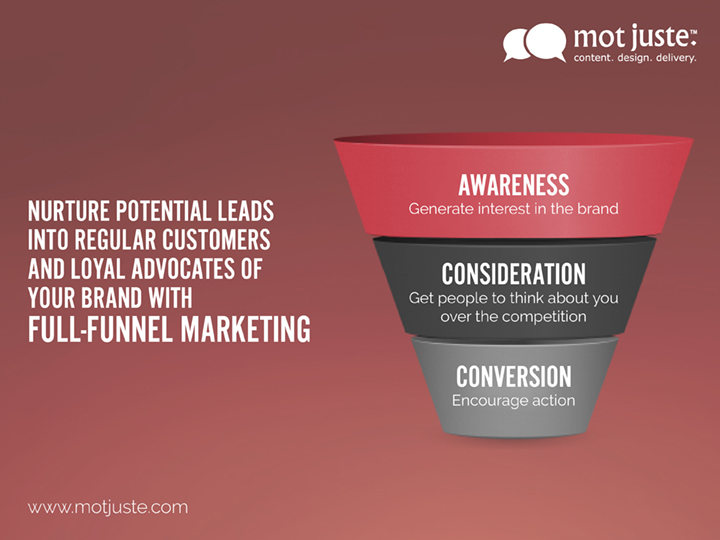
The marketing funnel is a metaphorical funnel that helps to visualise the process through which targeted audiences – once unaware of a product/service – become potential leads and are then converted into customers. In a Utopian world, the marketing funnel would look like a cylinder where all of the targeted audiences become customers! In the real world, however, the audience thins down with each subsequent stage.
The basic marketing funnel has three stages, namely: Awareness, Consideration, Conversion. While this remains the basis, different organisations have developed their own unique sub-stages or steps through which they approach marketing. Here’s an example:
- Awareness
- Interest
- Consideration
- Intent (to purchase)
- Evaluation
- Purchase/Conversion
A full-funnel marketing campaign reaches potential customers based on wherever they fall within the marketing funnel. This means that, at each stage of the funnel, there are different audiences, different objectives and goals, and different types of messaging to undertake.
To put it simply, the campaign will involve doing whatever it takes to consciously lead or “nurture” the potential customer through the various stages of the marketing funnel. You can also look at it as the process that involves attempting to bring the marketing funnel as close to a cylinder as possible!
Here, we’ll take you through the different stages of an online full-funnel marketing campaign.
Stage 1: Awareness/Top-of-the-funnel (TOFU)
Objectives and goals:
At the very beginning of the full-funnel marketing campaign, there are two levels of awareness that you will need your audience to achieve. Firstly, they will need to become aware that they have a need. Secondly, they will need to be aware of your brand and your products, that serve the aforementioned need.
The goal is to attract traffic to your website and you will need to do this by helping them find useful content that interests them.
Techniques:
Because you want to show as many people as possible about who you are and what you do, you not only perfect your SEO to improve your visibility organically, but also invest in online text/display ads, video ads, and content marketing (blogs, infographics, podcasts) activities.
Stage 2: Consideration/Middle-of-the-Funnel (MOFU)
Objectives and goals:
This is where you really begin to nurture your leads and help them to think of your brand more highly (and more often) than they do about your competition.
Your goal, at this point, should be to help your audience see you as a trusted source of information, if not products or services. To this effect, you want them to take one step closer by subscribing to your blog, signing up for a free trial, or posting an enquiry.
Techniques:
Now that your audience is aware of your brand, the nature of work you are involved in, and how this can help them, it’s time to get them to think about you more. Paid search results and remarketing ads work well for brand recall.
But don’t stop there! Provide them with opportunities for moving ahead in the marketing funnel. For example, if they have seen and liked your blogs, ask them to sign up for solutions-based content like informative webinars, whitepapers, or tools such as calculators and templates.
Stage 3: Conversion/Bottom-of-the-Funnel (BOFU)
Objectives and goals:
Congratulations! Your preferred audience is aware of their need and they know about your brand as well as what you offer. They also think highly of your brand, enough to consider your products or services. Now, all you have to do is give them that final encouraging push to help them make the final decision to buy.
At this stage, the goal is to simply close the deal (although it is easier said than done)!
Techniques:
Encourage your leads by giving them a taste of what it would be like to opt for your products or services; perhaps a free sample, a complimentary consultation, or even a convincing demo if your product is one that can’t be given out in pocket-sized sachets!
Remember, the techniques you use here will vary – not just depending on what you are trying to sell, but also on what has motivated each of your leads to come this far in the marketing funnel.
Stage 4: Repeat!
Once you have successfully acquired a customer and helped them to make the purchase, think of them as a lead again! You have worked hard in bringing them so far, so you should make sure that you don’t let them go.
In other words, you need to see them as a potential candidate for becoming a repeat customer. As they have already built up trust towards your brand (considering the product/service you sold them met their expectations), it will be relatively easier to cross-sell or up-sell to them. You have also collected a lot of data about them during their journey through the marketing funnel the first time, and can use this to your advantage to serve them exactly what they need!
Repeat customers are also very important to your business for another reason: contributing to the “awareness” stage of the next marketing funnel! Once they have trusted you enough to buy from you again, they will definitely tell their family and friends about you. And, believe us when we say this – there is no marketing or sales strategy in the world that works better than good old word-of-mouth!
In a full-funnel marketing approach, it is important to remember that all four stages will be on – simultaneously. This is because different members of your targeted audience will move down the marketing funnel at different speeds. It might seem a little overwhelming but, with the right kind of expertise and manpower, you can easily orchestrate a full-funnel marketing campaign!
At Mot Juste, we have a team of content writers, designers, digital marketing specialists and other experts who can help you run a full-funnel marketing campaign from start to finish. To know more, visit www.motjuste.com or get in touch with us today!
